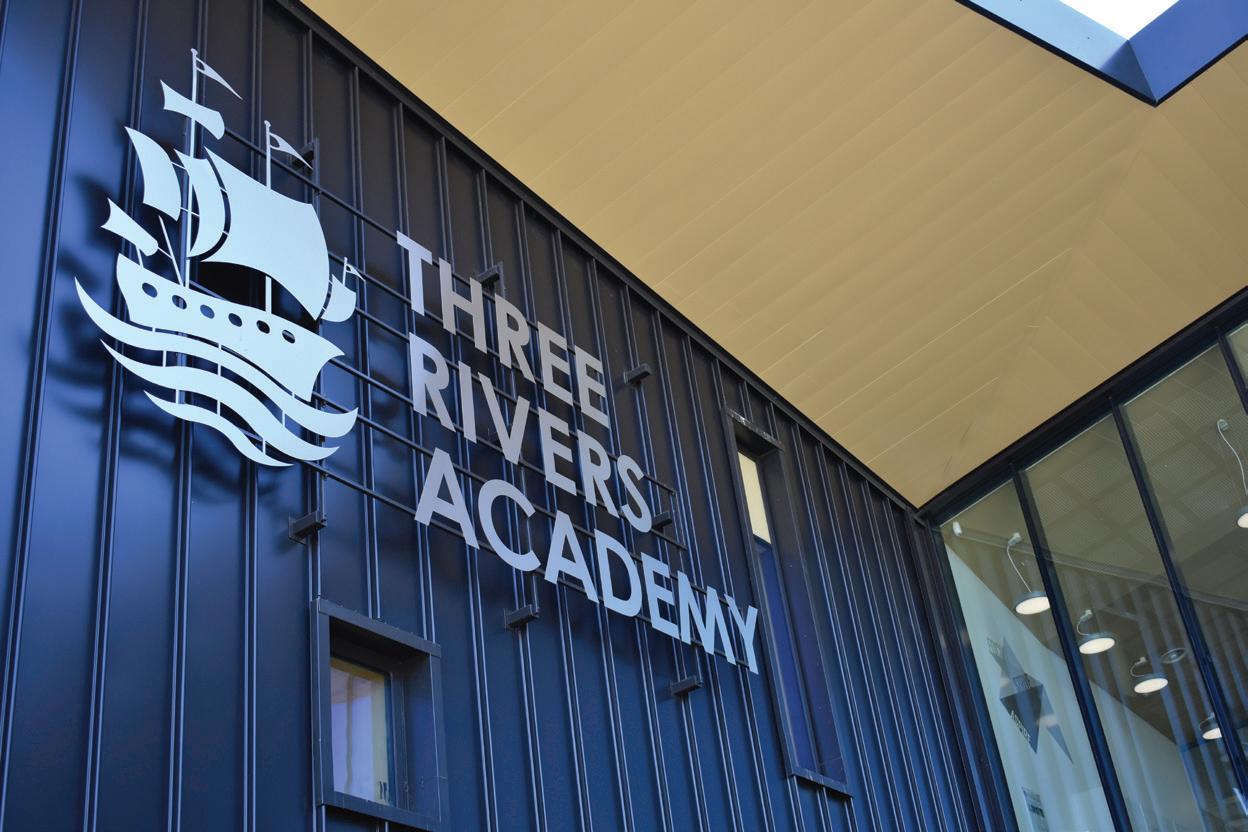
4 minute read
Are you sitting comfortably?
Staff offices are located at corners of circulation routes and next to breakout working spaces. Each has very generous windows allowing staff to model good working practices, to easily monitor passing ‘traffic’ and be easily accessible to students. Dining areas are located along the street with several serving points with a variety of food offerings and with several easy access doors to external spaces. It is a much more adult environment and reduces the need for staff to have to be the ‘ogre on duty’ during lesson changeover. Staff are everywhere, and the clever use of glass walls means that students can be seen from almost everywhere. The headteacher’s office is central and overlooks the ‘street’. A small shared staffroom is also strategically placed alongside a coffee bar accessed equally by staff and sixth form students. Travel times have been significantly reduced. Even the sports hall is part of the building, accessed through double doors. It was an interesting conversation during the design process as to whether the sports hall should be a separate building in its own right as so often happens. The main concern was that if it was included in the main building the smell of sweaty students and the noise would disturb the rest of the school. We were also concerned about students getting wet reaching a separate sports hall for PE lessons or
important exams. The final solution, with effective zoning, ventilation and acoustics, combined with a clever use of doors, has removed these issues. An added benefit is that the PE staff feel much more connected to the rest of the school and not isolated in their own building. The community aspect has not been forgotten. Careful secure zoning arrangements ensure that community can benefit from inside and outside spaces. “What do the students think?” One told the headteacher: “I feel like I’m coming to university each day”. Another student who had experienced the old building said “I’m now proud to tell people I come to Three Rivers Academy”. One of the key messages from the start of this project was how important the initial education design brief had been. Both the architects and building contractor described the brief as “the best that they had ever seen” which made the whole process so much easier from the very start of the project. The old adage rings true; the more work you put into the start of a project, the better the outcome will be. It is certainly true in this case.
Gareth Long is Director of the-learning-crowd educational consultancy. www.the-learning-crowd.com
Awards
Three Rivers Academy has been very successful and widely recognised, including: 2018 • Finalist, Best Student / Student experience • Finalist, World Architecture Awards • Listed, Inspiring School Designs from Around the Globe
2019 • Shortlisted, SPACES Awards, Civic Building of the Year
Are you sitting comfortably?
Sound ergonomics are not merely a ‘nice-to-have’ — they are intrinsic to good body and brain function both inside and outside the classroom, writes James Clarke.
Posture v Ergonomics Don’t be fooled by seats that simply claim to promote good posture because posture and ergonomics really mean two different things. Posture tends to refer mainly to how we hold our body, whereas sound ergonomic principles (whilst clearly impacting positively on your muscular-skeletal wellbeing) affect your cardio-vascular system too. This, in turn, has an impact on cognition. This was first proved in the first few years of the twenty-first century by the German ergonomist Dr Dieter Breithecker. In a four-year academic study (“The Educational Workplace” What the “classroom of the future” will look like. Breithecker et al 2005) he proved that when the body is mobile, cognition improves. It shouldn’t have been a surprise, because in all other walks of life we’re told to be active: we’re even told to walk up and down the aisle of a plane on a long-haul flight rather than sit for hours on end. Breithecker subsequently collaborated with German manufacturer VS in the design of their Panto Swing Chair. Together with the more recent Hokki stool, these designs actively promote movement, and therefore increase opportunities for concentration. Even when seated, the correct relationship between your thigh and abdomen — one where your internal organs are not constrained, isn’t the 90 degrees that sitting upright with your upper legs horizontal implies, but nearer 120 degrees – as if you’re riding a horse or a bicycle. Your ‘vital’ organs, mostly located in your lower abdomen all have arteries running through them, and if they’re in any way constrained, oxygenated blood is hindered from circulating around the body and ultimately getting to the brain, and that, in turn, clearly has an effect on cognition.
Concentration Performance value in the attentiveness strain test
A TTENTION
HOUR 1 HOUR 1 HOUR 1
Control School with active play equipment, traditional lessons School with active play equipment and agile curriculum
When a student leans back on their chair, they’re simply creating this wider angle. They’re not being naughty, but demonstrating one of the body’s natural, instinctive reflex reactions.
A little bit of history In part, the misunderstanding between the correct angle between thigh and thorax can be traced back to American industrial designer Henry Dreyfuss. In 1959, he published The Measure of Man — a publication that became a seminal piece, referred to by furniture designers for years to come. In it, he measured the human frame, including different statures and builds, and determined a set of ‘average’ measurements of the human form: the length of your lower leg, how far you can reach etc. However, his measurements relied on arbitrary angles between various parts of the body which in turn had a significant, if invisible, impact on how the body works. For example, the 5° backward incline in the seat that he shows in many of his diagrams in fact traps the popliteal








